Applications of GNSS-RO to Numerical Weather Prediction and Tropical Cyclone Forecast
Abstract
:1. Brief Introduction to GNSS-RO Technique
1.1. Principle of RO
1.2. RO Missions
- (1)
- COSMIC. On 15 April 2006, the first satellite constellation COSMIC designed for RO measurements was launched. It marked the beginning of the wide use of RO data in atmospheric and ionospheric sounding research from an operational standpoint [13]. Since then, COSMIC has provided 1500–2000 soundings per day globally, significantly contributing to numerical weather prediction (NWP) and meteorological studies [14]. Later, its follow-up mission was COSMIC-2, launched in June 2019; COSMIC-2 has provided approximately 5000 soundings per day over 35° N–35° S, mainly for tropical cyclone (TC) forecasting [15]. Such data are useful for short- and medium-range forecasts in the tropics, given the more accurate measurements of the temperature, humidity, and wind field [16]. The European Centre for Medium-Range Weather Forecasts (ECMWF) started to assimilate COSMIC-2 data at a rate of approximately 5000 soundings per day since March 2020.
- (2)
- MetOp. MetOp-A/B/C are three polar-orbiting meteorological satellites that form the space segment component of the overall EUMETSAT Polar System (EPS). MetOp-A was launched in 2006, and its RO data were found to contribute to weather forecasts up to 10 days ahead. This mission was followed by MetOp-B and C. Since March 2019, the ECMWF started to assimilate the bending angle from MetOp-C, with a quality similar to both MetOp-A and B measurements. Currently, the MetOp constellation can provide approximately 2000 soundings per day. As a next step, the EUMETSAT group has planned to launch six MetOp-second-generation (MetOp-SG) satellites. MetOp SG-A is scheduled for launch at the end of 2022.
- (3)
- FY-3C/D. FY-3C and D were launched in 2013 and 2017, respectively. The GNSS occultation sounder (GNOS) receiver onboard the FY-3C/D satellites is the first GPS and BeiDou-compatible sounder [17,18,19,20]. FY-3C can provide approximately 450–500 RO soundings per day for NWP. The FY-3D launched in 2020 can provide even more RO soundings, approximately 1000 per day. The GNOS-RO data have been used to study climate and TCs [21,22]. GNOS data have been assimilated into the operational NWP system of the ECMWF, Deutscher Wetterdienst (DWD), and Met Office [23]. Moreover, the FY-3-series satellites contain FY-3E/F/G/H and FY-3R, which are intended for rainfall observation. These missions are expected to be launched by 2025 and will provide ten years of continuous RO data. An advanced GNOS receiver (GNOS II) has been designed for the FY-3E satellite, making FY-3E applicable for monitoring sea waves as well [24].
1.3. Advantages of RO
2. Research and Applications of RO in NWP
2.1. Progress in the Application of RO to NWP
2.2. Impact of the Amount of RO Data on NWP and Future Trends
3. Research and Applications of RO to TC Forecast
3.1. Status of TC Forecast
3.2. Effect of RO Data on TC Forecasts
3.3. Effect of RO Assimilation Operator on TC Forecasts
4. Outlook
4.1. Trends Toward Increasing the Amount of RO Soundings
4.1.1. Multi-System-Compatible RO Receivers
4.1.2. Commercial Cube Satellite Constellation
4.1.3. Airborne RO Technique
4.2. Trends Toward Expanding New Features of RO
4.2.1. Polarimetric RO Technique
4.2.2. Multi-Feature GNSS Receiver
5. Conclusions
Author Contributions
Funding
Conflicts of Interest
References
- Ho, S.-P.; Goldberg, M.; Kuo, Y.-H.; Zou, C.-Z.; Shiau, W. Calibration of Temperature in the Lower Stratosphere from Microwave Measurements Using COSMIC Radio Occultation Data: Preliminary Results. Terr. Atmos. Ocean. Sci. 2009, 20, 87. [Google Scholar] [CrossRef] [Green Version]
- Steinerl, A.K.; Kirchengastl, G.; Foelsche, U.; Kornblueh, L.; Manzinil, E.; Bengtsson, L. GNSS occultation sounding for climate monitoring. Phys. Chem. Earth Part A Solid Earth Geod. 2001, 26, 113–124. [Google Scholar] [CrossRef]
- Jin, S.; Cardellach, E.; Xie, F. GNSS Remote Sensing: Theory, Methods and Applications. In Remote Sensing and Digital Image Processing; Springer: Berlin, Germany, 2014. [Google Scholar]
- Bai, W.; Wang, G.; Sun, Y.; Shi, J.; Yang, G.; Meng, X.; Wang, D.; Du, Q.; Wang, X.; Xia, J.; et al. Application of the Fengyun 3 C GNSS occultation sounder for assessing the global ionospheric response to a magnetic storm event. Atmos. Meas. Tech. 2019, 12, 1483–1493. [Google Scholar] [CrossRef] [Green Version]
- Kursinski, E.R.; Hajj, G.A.; Schofield, J.T.; Linfield, R.P.; Hardy, K.R. Observing Earth’s atmosphere with radio occultation measurements using the Global Positioning System. J. Geophys. Res. Space Phys. 1997, 102, 23429–23465. [Google Scholar] [CrossRef]
- Palmer, P.I.; Barnett, J.J. Application of an optimal estimation inverse method to GPS/MET bending angle observations. J. Geophys. Res. Space Phys. 2001, 106, 17147–17160. [Google Scholar] [CrossRef] [Green Version]
- Zhen, Z.; Xiong, H.; Zhang, X.J. Comparison of Density and Temperature Profile Measurement with Lidar and Occultation Technique. In Proceedings of the 2000 5th International Symposium on Antennas, Propagation, and EM Theory, Beijing, China, 15–18 August 2000; pp. 560–564. [Google Scholar]
- Wickert, J.; Reigber, C.; Beyerle, G.; König, R.; Marquardt, C.; Schmidt, T.; Grunwaldt, L.; Galas, R.; Meehan, T.K.; Melbourne, W.G.; et al. Atmosphere sounding by GPS radio occultation: First results from CHAMP. Geophys. Res. Lett. 2001, 28, 3263–3266. [Google Scholar] [CrossRef] [Green Version]
- Wickert, J.; Schmidt, T.; Beyerle, G.; König, R.; Reigber, C.; Jakowski, N. The Radio Occultation Experiment aboard CHAMP: Operational Data Analysis and Validation of Vertical Atmospheric Profiles. J. Meteorol. Soc. Jpn. 2004, 82, 381–395. [Google Scholar] [CrossRef] [Green Version]
- Wickert, J.; Michalak, G.; Schmidt, T.; Beyerle, G.; Cheng, C.Z.; Healy, S.B.; Heise, S.; Huang, C.Y.; Jakowski, N.; Köhler, W.; et al. GPS Radio Occultation: Results from CHAMP, GRACE and FORMOSAT-3/COSMIC. Terr. Atmos. Ocean. Sci. 2009, 20, 35–50. [Google Scholar] [CrossRef] [Green Version]
- Hajj, G.A.; Ao, C.O.; Iijima, B.A.; Kuang, D.; Kursinski, E.R.; Mannucci, A.J.; Meehan, T.; Romans, L.J.; De La Torre-Juárez, M.; Yunck, T.P. CHAMP and SAC-C atmospheric occultation results and intercomparisons. J. Geophys. Res. Space Phys. 2004, 109, D6. [Google Scholar] [CrossRef]
- Oscar. Available online: https://www.wmo-sat.info/oscar/gapanalyses?mission=9 (accessed on 15 August 2020).
- Anthes, R.A. Exploring Earth’s Atmosphere with Radio Occultation: Contributions to Weather, Climate and Space Weather. Atmos. Meas. Tech. 2011, 4, 1077–1103. [Google Scholar] [CrossRef] [Green Version]
- Anthes, A.R.; Bernhardt, A.P.; Chen, Y.; Cucurull, L.; Dymond, K.F.; Ector, D.; Healy, S.B.; Ho, S.-P.; Hunt, D.C.; Kuo, Y.-H.; et al. The COSMIC/FORMOSAT-3 Mission: Early Results. Bull. Am. Meteorol. Soc. 2008, 89, 313–334. [Google Scholar] [CrossRef]
- Ho, S.-P.; Anthes, R.A.; Ao, C.O.; Healy, S.; Horanyi, A.; Hunt, D.; Mannucci, A.J.; Pedatella, N.; Randel, W.J.; Simmons, A.; et al. The COSMIC/FORMOSAT-3 Radio Occultation Mission after 12 Years: Accomplishments, Remaining Challenges, and Potential Impacts of COSMIC-2. Bull. Am. Meteorol. Soc. 2020, 101, E1107–E1136. [Google Scholar] [CrossRef] [Green Version]
- Healy, S. ECMWF Starts Assimilating Cosmic-2 Data. Available online: https://www.ECMWF.int/en/newsletter/163/.news/ECMWF-starts-assimilating-cosmic-2-data (accessed on 20 July 2020).
- Bai, W.; Liu, C.; Meng, X.; Sun, Y.; Kirchengast, G.; Du, Q.; Wang, X.; Yang, G.; Liao, M.; Yang, Z.; et al. Evaluation of atmospheric profiles derived from single- and zero-difference excess phase processing of BeiDou radio occultation data from the FY-3C GNOS mission. Atmos. Meas. Tech. 2018, 11, 819–833. [Google Scholar] [CrossRef] [Green Version]
- Wang, S.Z.; Zhu, G.W.; Bai, W.H.; Liu, C.L.; Sun, Y.Q.; Wang, X.Y.; Meng, X.G.; Yang, G.L.; Yang, Z.D.; Zhang, X.X.; et al. For the First Time Fengyun3 C Satellite-Global Navigation Satellite System Occultation Sounder Achieved Spaceborne Bei Dou System Radio Occultation. Acta Phys. Sin. 2015, 64, 089301-1–089301-9. [Google Scholar]
- Du, Q.; Sun, Y.; Bai, W.; Wang, X.; Wang, D.; Meng, X.; Cai, Y.; Liu, C.; Wu, D.; Wu, C.; et al. The next generation GNOS instrument for FY-3 meteorological satellites. In Proceedings of the 2016 IEEE International Geoscience and Remote Sensing Symposium (IGARSS), Beijing, China, 10–15 July 2016; pp. 381–383. [Google Scholar]
- Bai, W.; Sun, Y.; Du, Q.; Yang, G.; Yang, Z.; Zhang, P.; Bi, Y.; Wang, X.; Wang, D.; Meng, X. An Introduction to FY3 GNOS in-Orbit Performance and Preliminary Validation Results. In Proceedings of the EGU General Assembly Conference, Vienna, Austria, 27 April–2 May 2014. [Google Scholar]
- Ma, G.; Wang, Y.; Yuan, B.; Xi, S.; Liao, M.; Zhang, P. Assimilation Application of Satellite Cloud Drive Wind and Radio Occultation and Its Impact to Rainfall and Cloudy Region. In Proceedings of the 33rd Chinese meteorology union Annual Meeting, Xi’an, China, 2–4 November 2016. [Google Scholar]
- Liu, Z.; Sun, Y.; Bai, W.; Xia, J.; Tan, G.; Cheng, C.; Du, Q.; Wang, X.; Zhao, D.; Tian, Y.; et al. Validation of Preliminary Results of Thermal Tropopause Derived from FY-3C GNOS Data. Remote Sens. 2019, 11, 1139. [Google Scholar] [CrossRef] [Green Version]
- Liao, M.; Healy, S.; Zhang, P. Processing and quality control of FY-3C GNOS data used in numerical weather prediction applications. Atmos. Meas. Tech. 2019, 12, 2679–2692. [Google Scholar] [CrossRef] [Green Version]
- Sun, Y.; Tian, Y.; Liu, C.; Li, W.; Zhao, D.; Li, F.; Qiao, H.; Wang, X.; Du, Q.; Bai, W.; et al. The Status and Progress of Fengyun-3e GNOS II Mission for GNSS Remote Sensing. In Proceedings of the IGARSS 2019—2019 IEEE International Geoscience and Remote Sensing Symposium; Institute of Electrical and Electronics Engineers (IEEE), Yokohama, Japan, 28 July–2 August 2019; pp. 5181–5184. [Google Scholar]
- Romanov, A.; Selivanov, A.; Vishnyakov, V.; Vinogradov, A.; Selin, V.; Pavelyev, A.; Yakovlev, O.; Matyugov, S. Space System “Radiomet” for GLONASS/GPS Navigation Signal Radio Occultation Monitoring of Lower Atmosphere and Ionosphere Based on Super-Small Satellites. In Small Satellite Missions for Earth Observation; Springer: Berlin/Heidelberg, Germany, 2009; pp. 85–94. [Google Scholar]
- Ladreiter, H.P.; Kirchengast, G. GPS/GLONASS sensing of the neutral atmosphere: Model-independent correction of ionospheric influences. Radio Sci. 1996, 31, 877–891. [Google Scholar] [CrossRef]
- Kirchengast, G.; Høeg, P. The ACE+ Mission: An Atmosphere and Climate Explorer based on GPS, GALILEO, and LEO-LEO Radio Occultation. In Occultations for Probing Atmosphere and Climate; Springer: Berlin/Heidelberg, Germany, 2004; pp. 201–220. [Google Scholar]
- Borowitz, M. Is It Time for Commercial Weather Satellites? Analyzing the Case of Global Navigation Satellite System Radio Occultation. N. Space 2016, 4, 115–122. [Google Scholar] [CrossRef]
- Cai, Y.; Bai, W.; Wang, X.; Sun, Y.; Du, Q.; Zhao, D.; Meng, X.-G.; Liu, C.; Xia, J.; Wang, D.; et al. In-orbit performance of GNOS on-board FY3-C and the enhancements for FY3-D satellite. Adv. Space Res. 2017, 60, 2812–2821. [Google Scholar] [CrossRef]
- Jin, S.; Feng, G.; Gleason, S. Remote sensing using GNSS signals: Current status and future directions. Adv. Space Res. 2011, 47, 1645–1653. [Google Scholar] [CrossRef]
- Scherllin-Pirscher, B.; Steiner, A.K.; Kirchengast, G.; Schwärz, M.; Leroy, S.S. The power of vertical geolocation of atmospheric profiles from GNSS radio occultation. J. Geophys. Res. Atmos. 2017, 122, 1595–1616. [Google Scholar] [CrossRef] [PubMed]
- Gorbunov, M.E.; Benzon, H.-H.; Jensen, A.S.; Lohmann, M.S.; Nielsen, A.S. Comparative analysis of radio occultation processing approaches based on Fourier integral operators. Radio Sci. 2004, 39, 1–11. [Google Scholar] [CrossRef] [Green Version]
- Yu, X.; Xie, F.; Ao, C.O. Evaluating the lower-tropospheric COSMIC GPS radio occultation sounding quality over the Arctic. Atmos. Meas. Tech. 2018, 11, 2051–2066. [Google Scholar] [CrossRef] [Green Version]
- Emanuel, K. 100 Years of Progress in Tropical Cyclone Research. Meteorol. Monogr. 2018, 59, 15.1–15.68. [Google Scholar] [CrossRef]
- Wilgan, K.; Rohm, W.; Bosy, J. Multi-observation meteorological and GNSS data comparison with Numerical Weather Prediction model. Atmos. Res. 2015, 156, 29–42. [Google Scholar] [CrossRef]
- Ho, S.-P.; Kirchengast, G.; Leroy, S.; Wickert, J.; Mannucci, A.J.; Steiner, A.K.; Hunt, D.; Schreiner, W.; Sokolovskiy, S.; Ao, C.; et al. Estimating the uncertainty of using GPS radio occultation data for climate monitoring: Intercomparison of CHAMP refractivity climate records from 2002 to 2006 from different data centers. J. Geophys. Res. Space Phys. 2009, 114, 114. [Google Scholar] [CrossRef] [Green Version]
- Luntama, J.-P.; Kirchengast, G.; Borsche, M.; Foelsche, U.; Steiner, A.K.; Healy, S.; Von Engeln, A.; O’Clerigh, E.; Marquardt, C. Prospects of the EPS GRAS Mission For Operational Atmospheric Applications. Bull. Am. Meteorol. Soc. 2008, 89, 1863–1876, © American Meteorological Society. Used with permission. [Google Scholar] [CrossRef] [Green Version]
- Cucurull, L. Improvement in the Use of an Operational Constellation of GPS Radio Occultation Receivers in Weather Forecasting. Weather Forecast. 2010, 25, 749–767. [Google Scholar] [CrossRef]
- Buontempo, C.; Jupp, A.; Rennie, M. Operational NWP assimilation of GPS radio occultation data. Atmos. Sci. Lett. 2008, 9, 129–133. [Google Scholar] [CrossRef]
- Healy, S.B. Forecast impact experiment with a constellation of GPS radio occultation receivers. Atmos. Sci. Lett. 2008, 9, 111–118. [Google Scholar] [CrossRef]
- Healy, S.B.; Thépaut, J.-N. Assimilation experiments with CHAMP GPS radio occultation measurements. Q. J. R. Meteorol. Soc. 2006, 132, 605–623. [Google Scholar] [CrossRef]
- Healy, S.B. Operational Assimilation of GPS Radio Occultation Measurements at ECMWF. ECMWF Newsl. 2007, 111, 6–11. [Google Scholar]
- Lagasio, M.; Pulvirenti, L.; Parodi, A.; Boni, G.; Pierdicca, N.; Venuti, G.; Realini, E.; Tagliaferro, G.; Barindelli, S.; Rommen, B. Effect of the ingestion in the WRF model of different Sentinel-derived and GNSS-derived products: Analysis of the forecasts of a high impact weather event. Eur. J. Remote Sens. 2019, 52, 1–18. [Google Scholar] [CrossRef] [Green Version]
- Cardinali, C.; Healy, S. Impact of GPS radio occultation measurements in the ECMWF system using adjoint-based diagnostics. Q. J. R. Meteorol. Soc. 2014, 140, 2315–2320. [Google Scholar] [CrossRef]
- Bauer, P.; Radnóti, G.; Healy, S.; Cardinali, C. GNSS Radio Occultation Constellation Observing System Experiments. Mon. Weather Rev. 2014, 142, 555–572, © American Meteorological Society. Used with permission. [Google Scholar] [CrossRef]
- Harnisch, F.; Healy, S.B.; Bauer, P.; English, S.J. Scaling of GNSS Radio Occultation Impact with Observation Number Using an Ensemble of Data Assimilations. Mon. Weather Rev. 2013, 141, 4395–4413, © American Meteorological Society. Used with permission. [Google Scholar] [CrossRef]
- Zhang, B.; Ho, S.P.; Shao, X.; Cao, C. Error Assessments in the GNSS Radio Occultation Excess Phase/Bending Angle Calculation. In Proceedings of the CISESS/UMD Annual Science Meeting, College Park, MD, USA, 12–14 November 2019. [Google Scholar]
- ECMWF. Available online: https://www.ECMWF.int/en/forecasts/charts/obstat/?facets=Parameter,Bending%20angles (accessed on 15 August 2020).
- Halperin, D.J.; Fuelberg, H.E.; Hart, R.E.; Cossuth, J.H. Verification of Tropical Cyclone Genesis Forecasts from Global Numerical Models: Comparisons between the North Atlantic and Eastern North Pacific Basins. Weather Forecast. 2016, 31, 947–955, © American Meteorological Society. Used with permission. [Google Scholar] [CrossRef]
- Halperin, D.J.; Fuelberg, H.E.; Hart, R.E.; Cossuth, J.H.; Sura, P.; Pasch, R.J. An Evaluation of Tropical Cyclone Genesis Forecasts from Global Numerical Models. Weather Forecast. 2013, 28, 1423–1445. [Google Scholar] [CrossRef]
- Tory, K.J.; Frank, W.M.; Chan, J.C.L.; Kepert, J. Tropical Cyclone Formation. In The Global Monsoon System; World Scientific: Singapore, 2010; pp. 55–91. [Google Scholar]
- Biondi, R.; Neubert, T.; Syndergaard, S.; Nielsen, J. Cosmic Radio Occultation Technique for Measurement of the Tropopause During Tropical Cyclones. In Proceedings of the Fourth FORMOSAT-3/COSMIC Data Users Workshop, Boulder, CO, USA, 27–29 October 2009. [Google Scholar]
- Biondi, R.; Neubert, T.; Ho, S.P.; Syndergaard, S. Tropical Cyclones Detection Using GPS Radio Occultation Data. In Proceedings of the IUGG: Earth on the Edge: Science for a Sustainable Planet, Melbourne, Australia, 28 June–7 July 2011; pp. 920–933. [Google Scholar]
- Huang, C.-Y.; Kuo, Y.-H.; Chen, S.-Y.; Terng, C.-T.; Chien, F.-C.; Lin, P.-L.; Kueh, M.-T.; Chen, S.-H.; Yang, M.-J.; Wang, C.-J.; et al. Impact of GPS radio occultation data assimilation on regional weather predictions. GPS Solut. 2009, 14, 35–49. [Google Scholar] [CrossRef]
- Hsieh, M.E.; Chen, Y.C.; Hsiao, L.F.; Chang, L.Y.; Huang, C.Y. Case Study of Impact of Assimilating Metop GPS Radio Occultation Observation on Top of Cosmic Data on Typhoon Forecast. J. Aeronaut. Astronaut. Aviat. 2018, 50, 375–390. [Google Scholar]
- Phunthirawuthi, P.; Wu, F.; Boonyuen, P. Performance analysis of GPS Radio Occultation assimilation for tropical cyclone monitoring. In Proceedings of the 2016 IEEE International Geoscience and Remote Sensing Symposium (IGARSS); Institute of Electrical and Electronics Engineers (IEEE), Beijing, China, 10–15 July 2016; pp. 2181–2184. [Google Scholar]
- Chen, S.-Y.; Wee, T.-K.; Kuo, Y.-H.; Bromwich, D.H. An Impact Assessment of GPS Radio Occultation Data on Prediction of a Rapidly Developing Cyclone over the Southern Ocean. Mon. Weather Rev. 2014, 142, 4187–4206. [Google Scholar] [CrossRef] [Green Version]
- Chen, Y.C.; Hsieh, M.E.; Hsiao, L.F.; Kuo, Y.H.; Yang, M.J.; Huang, C.Y.; Lee, C.S. Systematic Evaluation of the Impacts of GPSRO Data on the Prediction of Typhoons over the Northwestern Pacific in 2008–2010. Atmos. Meas. Tech. 2015, 8, 2531–2542. [Google Scholar] [CrossRef] [Green Version]
- Chen, S.Y.; Zhao, H.; Huang, C.Y. Impacts of GNSS Radio Occultation Data on Predictions of Two Super-Intense Typhoons with Wrf Hybrid Variational-Ensemble Data Assimilation. J. Aeronaut. Astronaut. Aviat. 2018, 50, 347–364. [Google Scholar]
- Kuo, Y.H.; Liu, H. The Use of GPS Radio Occultation Data for Tropical Cyclones Prediction. In Proceedings of the 2nd IROWG Workshop, Estes Park, CO, USA, 28 March–3 April 2012. [Google Scholar]
- Liu, H.; Anderson, J.; Kuo, Y.-H. Improved Analyses and Forecasts of Hurricane Ernesto’s Genesis Using Radio Occultation Data in an Ensemble Filter Assimilation System. Mon. Weather Rev. 2012, 140, 151–166, © American Meteorological Society. Used with permission. [Google Scholar] [CrossRef] [Green Version]
- Anisetty, S.P.R.; Huang, C.Y.; Chen, S.Y. Impact of Formosat-3/Cosmic Radio Occultation Data on the Prediction of Super Cyclone Gonu (2007): A Case Study. Nat. Hazards 2014, 70, 1209–1230. [Google Scholar] [CrossRef]
- Vergados, P.; Mannucci, A.J.; Su, H. A validation study for GPS radio occultation data with moist thermodynamic structure of tropical cyclones. J. Geophys. Res. Atmos. 2013, 118, 9401–9413. [Google Scholar] [CrossRef]
- Unwin, M.; Duncan, S.; Jales, P.; Blunt, P.; Tye, J. Implementing GNSS-Reflectometry in Space on the Techdemosat-1 Mission. In Proceedings of the 27th International Technical Meeting of the Satellite Division of The Institute of Navigation (ION GNSS+ 2014), Tampa Convention Center, Tampa, FL, USA, 8–12 September 2014. [Google Scholar]
- Sokolovskiy, S.V.; Kuo, Y.-H.; Wang, W. Assessing the Accuracy of a Linearized Observation Operator for Assimilation of Radio Occultation Data: Case Simulations with a High-Resolution Weather Model. Mon. Weather Rev. 2005, 133, 2200–2212. [Google Scholar] [CrossRef] [Green Version]
- Liu, H.; Zou, X. Improvements to a GPS radio occultation ray-tracing model and their impacts on assimilation of bending angle. J. Geophys. Res. Space Phys. 2003, 108. [Google Scholar] [CrossRef]
- Healy, S.B. Assimilation of GPS Radio Occultation Measurements at ECMWF. In Proceedings of the GRAS SAF Workshop on Applications of GPSRO measurements, ECMWF, Reading, UK, 16–18 June 2008; pp. 16–18. [Google Scholar]
- Ma, Z.; Kuo, Y.H.; Wang, B.; Wu, W.S.; Sokolovskiy, S. Comparison of Local and Non-local Observation Operators for the Assimilation of GPS Ro Data with the Ncep Gsi System: An Osse Study. Mon. Weather Rev. 2009, 137, 3575–3587. [Google Scholar] [CrossRef] [Green Version]
- Zou, X.; Hui, L. Impact Multipath Quality Control Improving GPS Ro Data Assimilation in the Tropical Lower Troposphere. Trans. Atmos. Sci. 2020, 1, 116–127. [Google Scholar]
- Ma, Z.; Kuo, Y.-H.; Ralph, F.M.; Neiman, P.J.; Wick, G.A.; Sukovich, E.; Wang, B. Assimilation of GPS Radio Occultation Data for an Intense Atmospheric River with the NCEP Regional GSI System. Mon. Weather Rev. 2011, 139, 2170–2183. [Google Scholar] [CrossRef] [Green Version]
- Liu, H.; Anderson, J.; Kuo, Y.H.; Snyder, C.; Caya, A. Evaluation of a Non-local Quasi-Phase Observation Operator in Assimilation of Champ Radio Occultation Refractivity with Wrf. Mon. Weather Rev. 2008, 136, 242–256. [Google Scholar] [CrossRef]
- Ha, J.-H.; Lim, G.-H.; Choi, S.-J. Assimilation of GPS Radio Occultation Refractivity Data with WRF 3DVAR and Its Impact on the Prediction of a Heavy Rainfall Event. J. Appl. Meteorol. Clim. 2014, 53, 1381–1398. [Google Scholar] [CrossRef]
- Chen, S.Y.; Huang, C.Y.; Kuo, Y.H.; Guo, Y.R.; Sokolovskiy, S. Assimilation of GPS Refractivity from Formosat-3/Cosmic Using a Non-local Operator with WRF 3Dvar and Its Impact on the Prediction of a Typhoon Event. Terr. Atmos. Ocean. Sci. 2009, 20, 133–154. [Google Scholar] [CrossRef] [Green Version]
- Cheng, W.; Wang, B.; Xu, Y. Assimilation of GPS Radio Occultation Data with the Local and Non-Local Op- Erators Using Backward-4dvar Approach. Sci. Sin. Math. 2012, 42, 377–387. (In Chinese) [Google Scholar]
- Chen, S.Y.; Kuo, Y.H.; Huang, C.Y. The Impact of GPS RO Data on the Prediction of Tropical Cyclogenesis Using a Non-local Observation Operator: An Initial Assessment. Mon. Weather Rev. 2020, 148, 2701–2717, © American Meteorological Society. Used with permission. [Google Scholar] [CrossRef]
- Biondi, R.; Steiner, A.K.; Kirchengast, G.; Rieckh, T. Characterization of thermal structure and conditions for overshooting of tropical and extratropical cyclones with GPS radio occultation. Atmos. Chem. Phys. Discuss. 2015, 15, 5181–5193. [Google Scholar] [CrossRef] [Green Version]
- Young, L. JPL GNSS Receivers, Past, Present, and Future; Jet Propulsion Laboratory, California Institute of Technology: La Cañada Flintridge, CA, USA, 2017. [Google Scholar]
- Masters, D.; Irisov, V.; Nguyen, V.; Duly, T.; Nogués-Correig, O.; Tan, L.; Yuasa, T.; Ringer, J.; Sikarin, R.; Gorbunov, M.; et al. Status and Plans for Spire’s Growing Commercial Constellation of GNSS Science CubeSats. In Proceedings of the Joint 6th ROM SAF User Workshop and 7th IROWG Workshop, Helsingør, Denmark, 19–25 September 2019. [Google Scholar]
- Bowler, N.E. An assessment of GNSS radio occultation data produced by Spire. Q. J. R. Meteorol. Soc. 2020. [Google Scholar] [CrossRef]
- Yunck, T.; Lautenbacher, C.; McGrath, M.; Withnell, P.; Axelrad, P.; Nuding, D.; Kreisher, J. CICERO—Community Initiative for Continuing Earth Radio Occultation. In Proceedings of the 6th FORMOSAT-3/COSMIC Data Users Workshop, Boulder, CO, USA, 30 October–1 November 2012. [Google Scholar]
- Rohm, W.; Yuan, Y.; Biadeglgne, B.; Zhang, K.; Le Marshall, J. Ground-based GNSS ZTD/IWV estimation system for numerical weather prediction in challenging weather conditions. Atmos. Res. 2014, 138, 414–426. [Google Scholar] [CrossRef]
- Ruf, C.S.; Atlas, R.; Chang, P.S.; Clarizia, M.P.; Garrison, J.L.; Gleason, S.; Katzberg, S.J.; Jelenak, Z.; Johnson, J.T.; Majumdar, S.J.; et al. New Ocean Winds Satellite Mission to Probe Hurricanes and Tropical Convection. Bull. Am. Meteorol. Soc. 2016, 97, 385–395. [Google Scholar] [CrossRef]
- Chen, X.M. Airborne Radio Occultation Measurements and Their Impact on Severe Weather Prediction Using the Regional WRF Model. Ph.D. Thesis, University of California, Davis, CA, USA, 2017. Available from ProQuest Dissertations & Theses Global; ProQuest Dissertations & Theses Global A&I: The Sciences and Engineering Collection. (2037164052). [Google Scholar]
- Turk, F.J.; Padullés, R.; Ao, C.O.; Juárez, M.D.L.T.; Wang, K.-N.; Franklin, G.W.; Lowe, S.T.; Hristova-Veleva, S.M.; Fetzer, E.; Cardellach, E.; et al. Benefits of a Closely-Spaced Satellite Constellation of Atmospheric Polarimetric Radio Occultation Measurements. Remote Sens. 2019, 11, 2399. [Google Scholar] [CrossRef] [Green Version]
- Cardellach, E.; Padullés, R.; Tomás, S.; Turk, F.J.; Ao, C.O.; De La Torre-Juárez, M. Probability of intense precipitation from polarimetric GNSS radio occultation observations. Q. J. R. Meteorol. Soc. 2017, 144, 206–220. [Google Scholar] [CrossRef] [PubMed]
- Cardellach, E.; Oliveras, S.; Rius, A.; Tomás, S.; Ao, C.O.; Franklin, G.W.; Iijima, B.A.; Kuang, D.; Meehan, T.K.; Padullés, R.; et al. Sensing Heavy Precipitation With GNSS Polarimetric Radio Occultations. Geophys. Res. Lett. 2019, 46, 1024–1031. [Google Scholar] [CrossRef] [Green Version]
- Dong, Z.; Jin, S. Evaluation of Spaceborne GNSS-R Retrieved Ocean Surface Wind Speed with Multiple Datasets. Remote Sens. 2019, 11, 2747. [Google Scholar] [CrossRef] [Green Version]
- Singh, S.K.; Kumar, P.; Pal, P.K. Assimilation of Oceansat-2-Scatterometer-Derived Surface Winds in the Weather Research and Forecasting Model. IEEE Trans. Geosci. Remote Sens. 2011, 50, 1015–1021. [Google Scholar] [CrossRef]
- Mohanty, U.C.; Gopalakrishnan, S.G. (Eds.) Advanced Numerical Modeling and Data Assimilation Techniques for Tropical Cyclone Prediction; Springer: Berlin, Germany, 2016. [Google Scholar]
- Benjamin, S.G.; Brown, J.M.; Brunet, G.; Lynch, P.; Saito, K.; Schlatter, T.W. 100 Years of Progress in Forecasting and NWP Applications. Meteorol. Monogr. 2019, 59, 13.1–13.67. [Google Scholar] [CrossRef]
- Yiğit, E.; Knížová, P.K.; Georgieva, K.; Ward, W. A review of vertical coupling in the Atmosphere–Ionosphere system: Effects of waves, sudden stratospheric warmings, space weather, and of solar activity. J. Atmos. Solar Terr. Phys. 2016, 141, 1–12. [Google Scholar] [CrossRef]
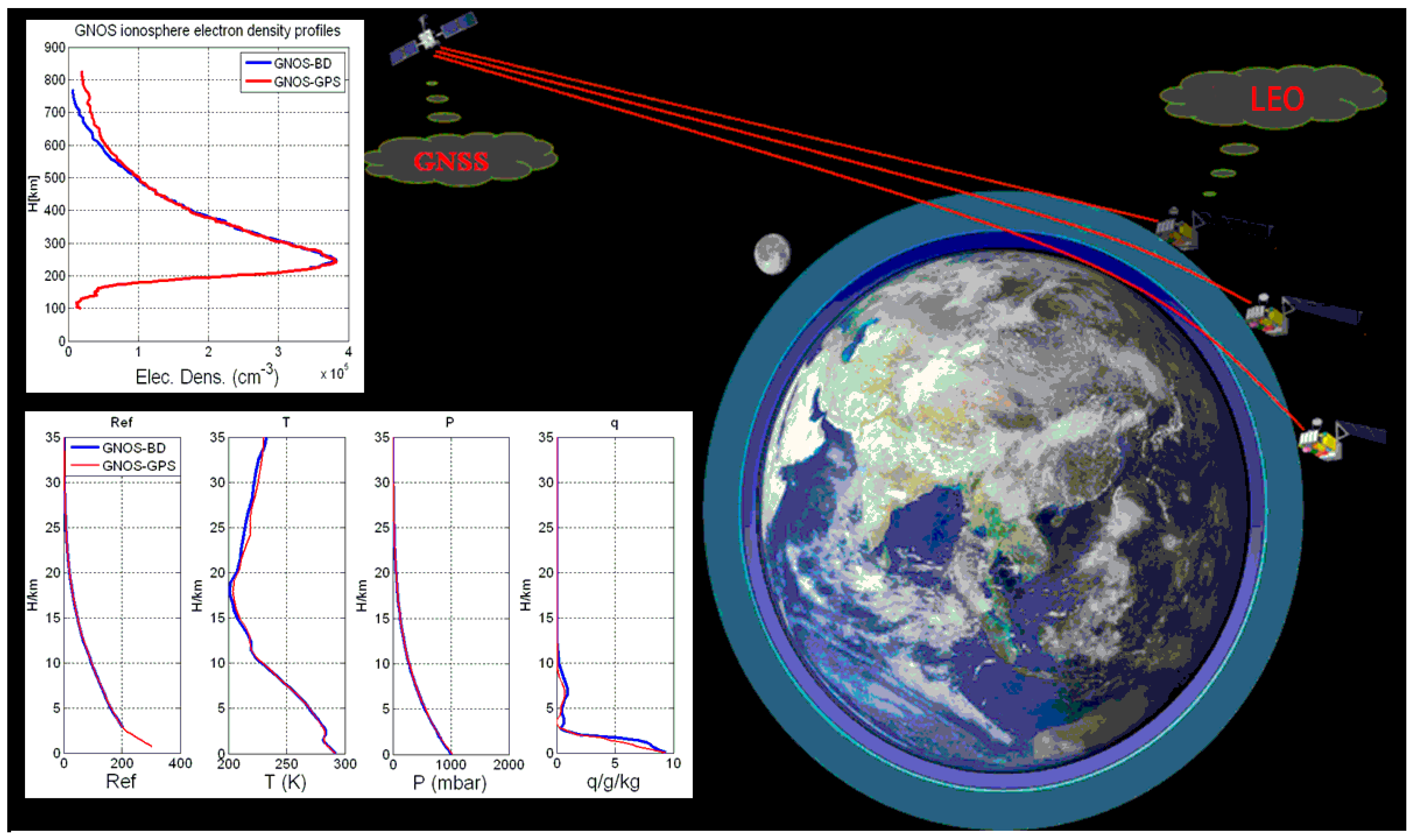
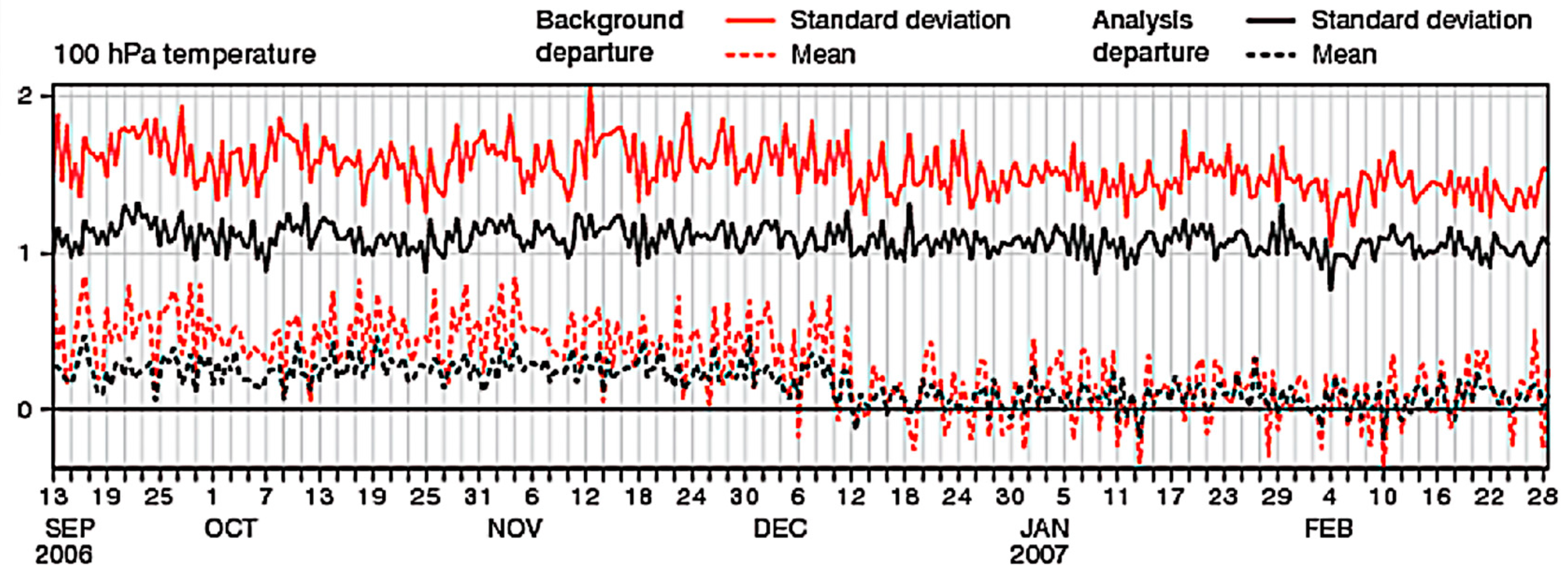
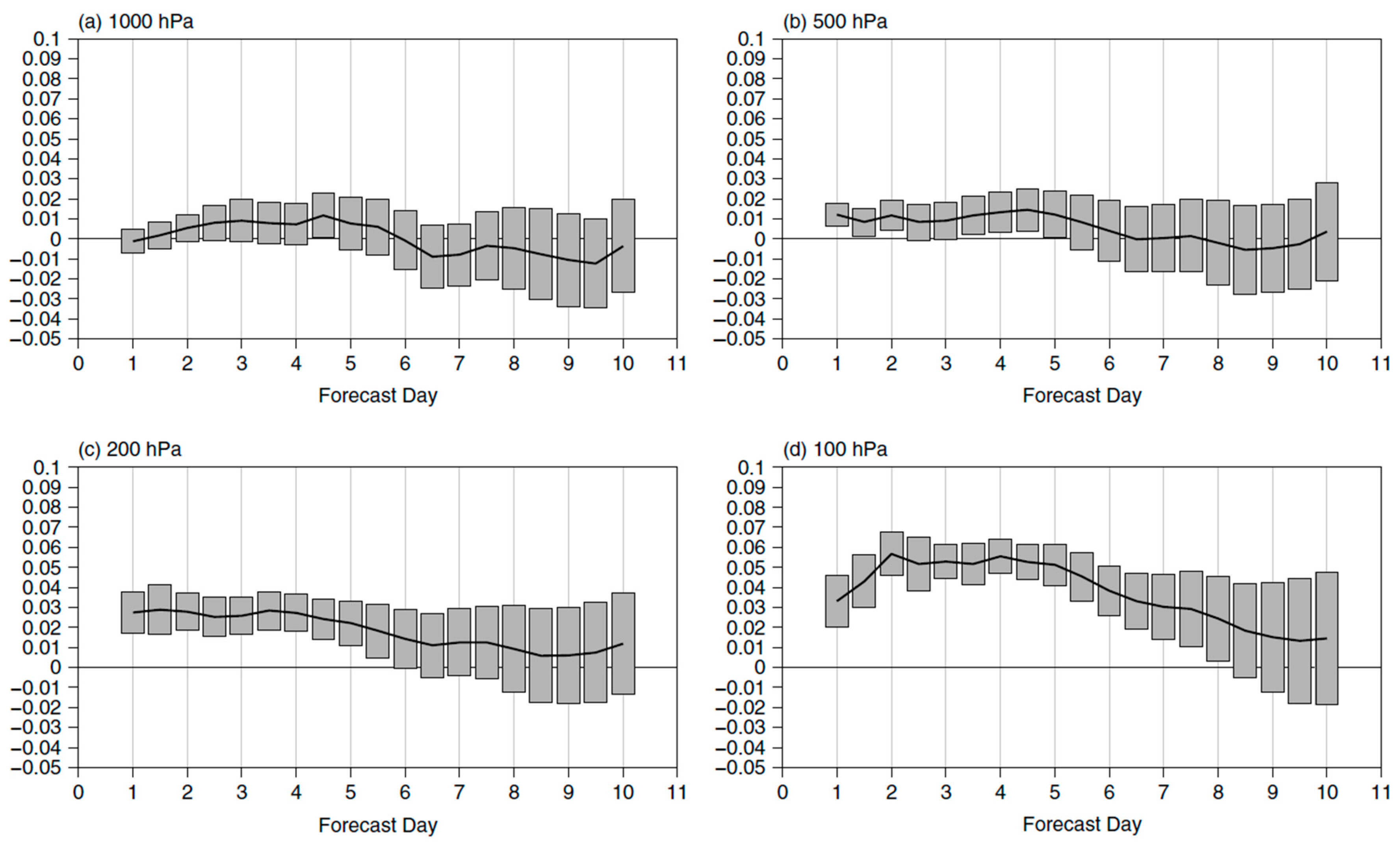

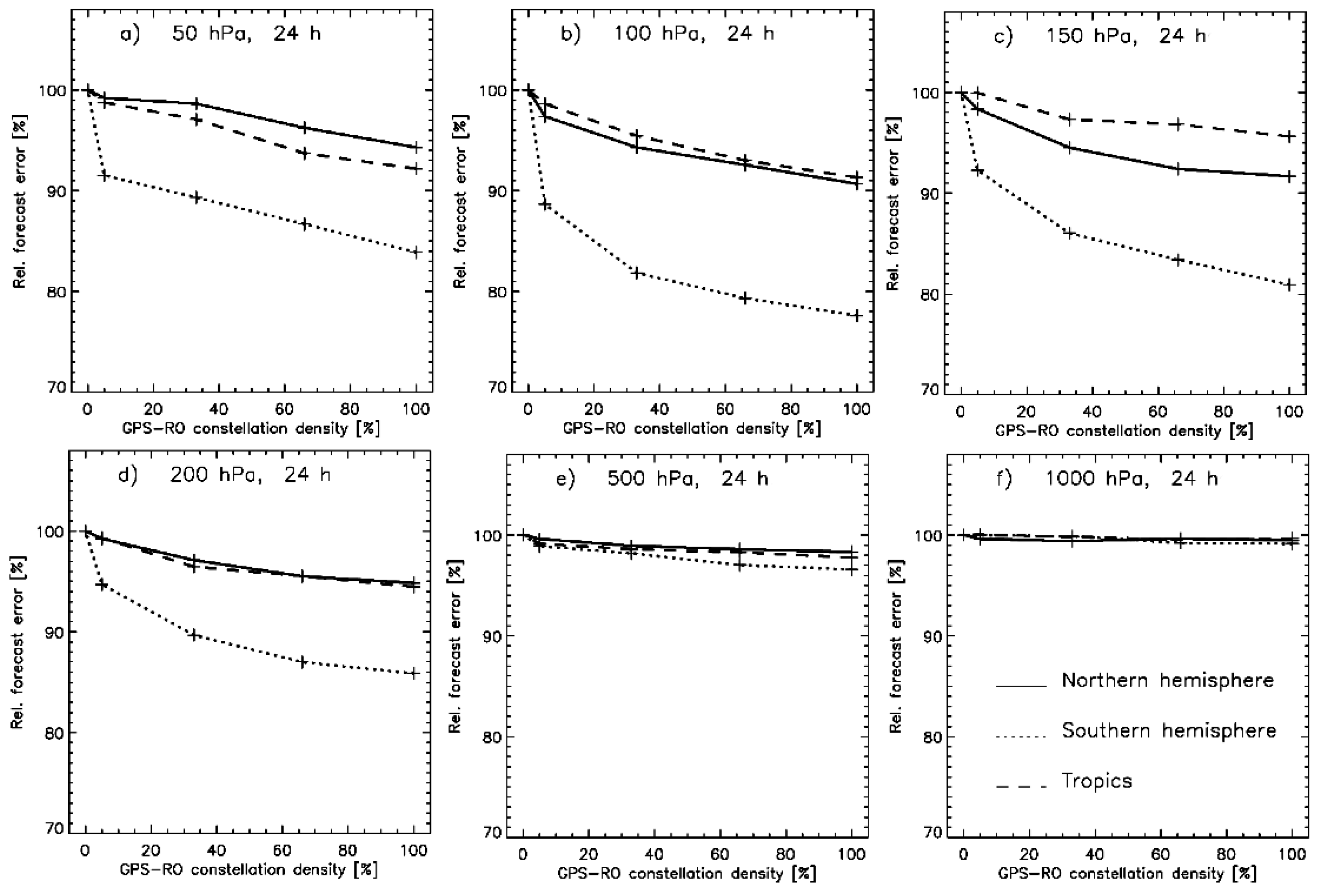

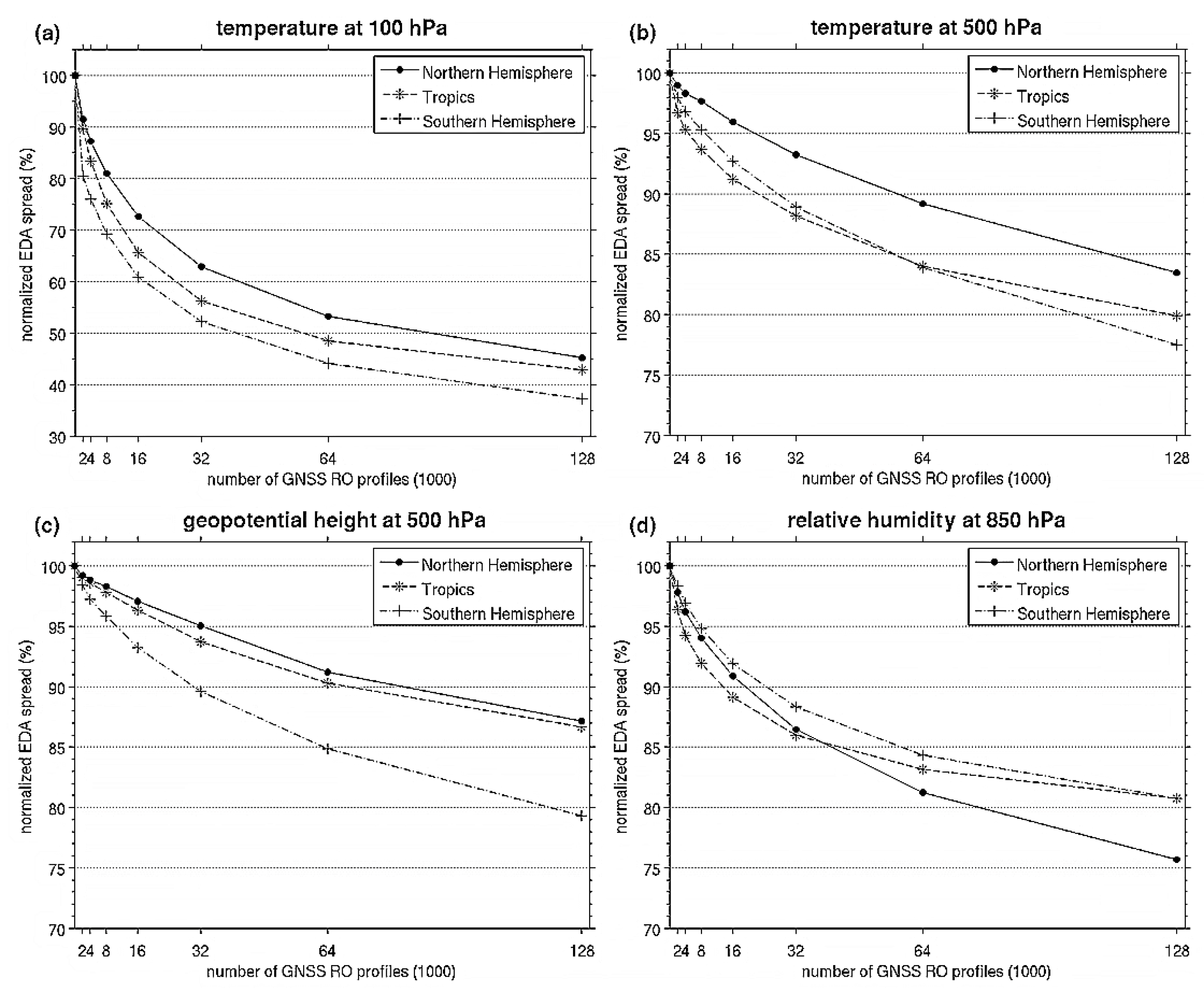

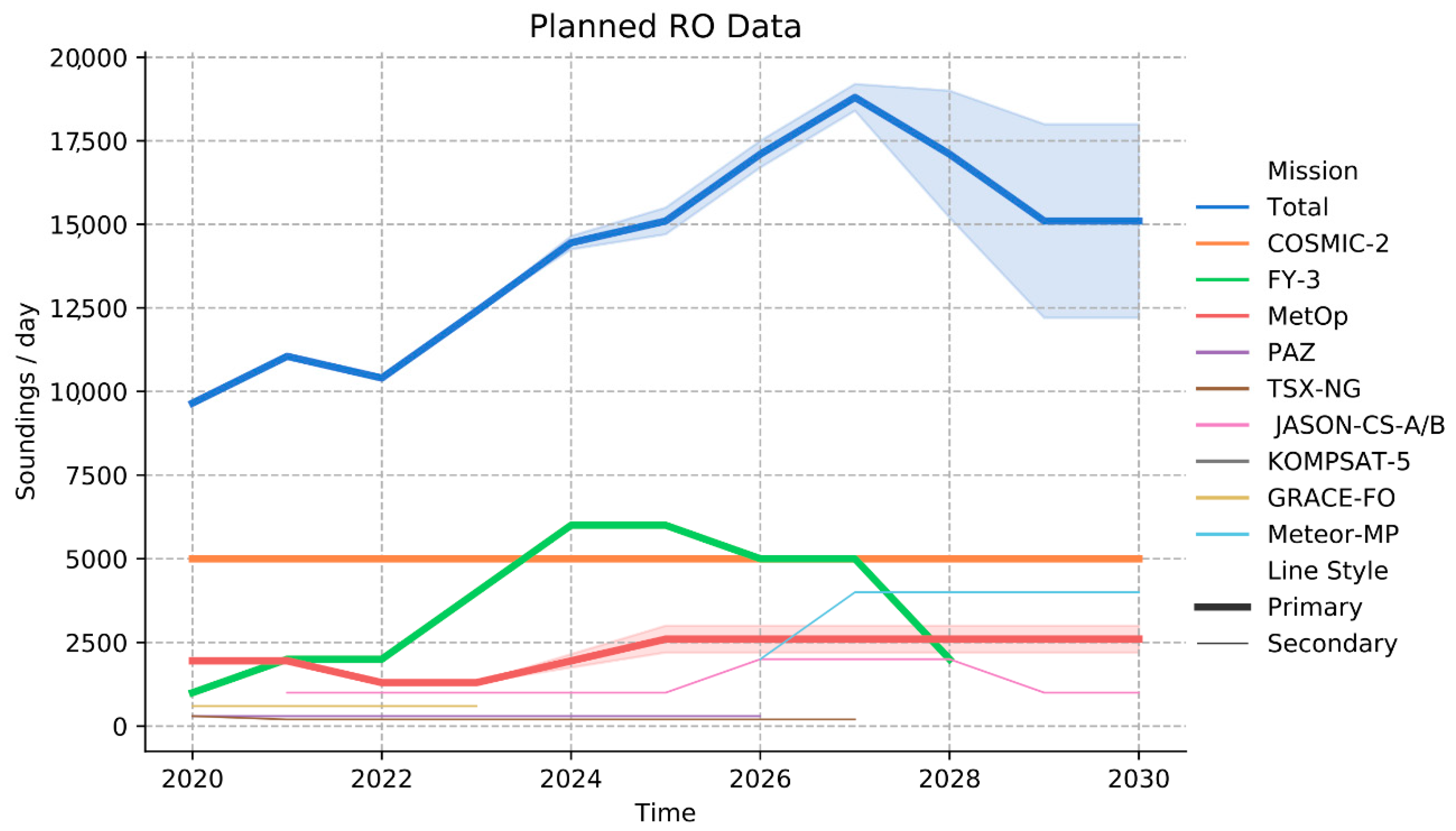
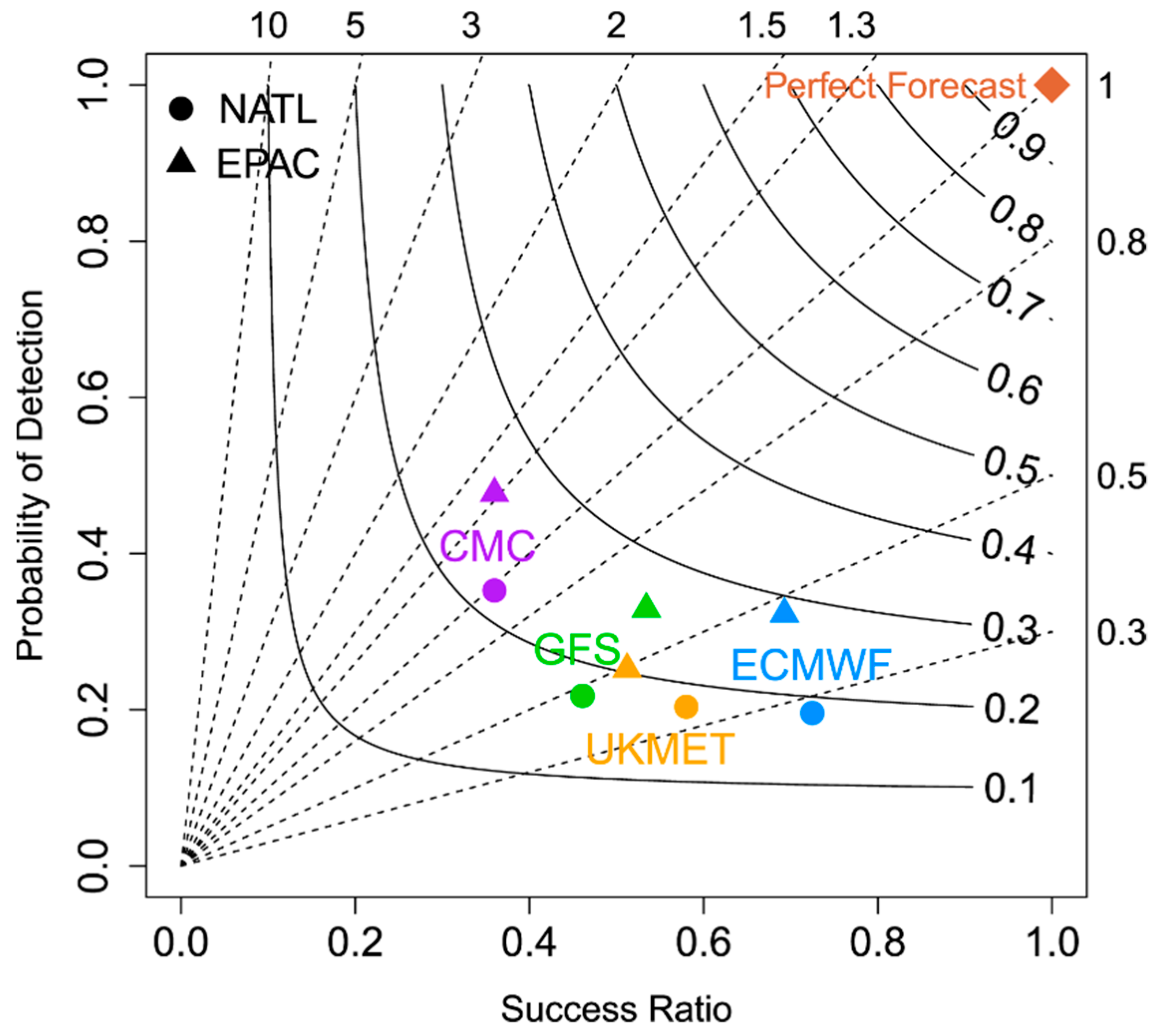
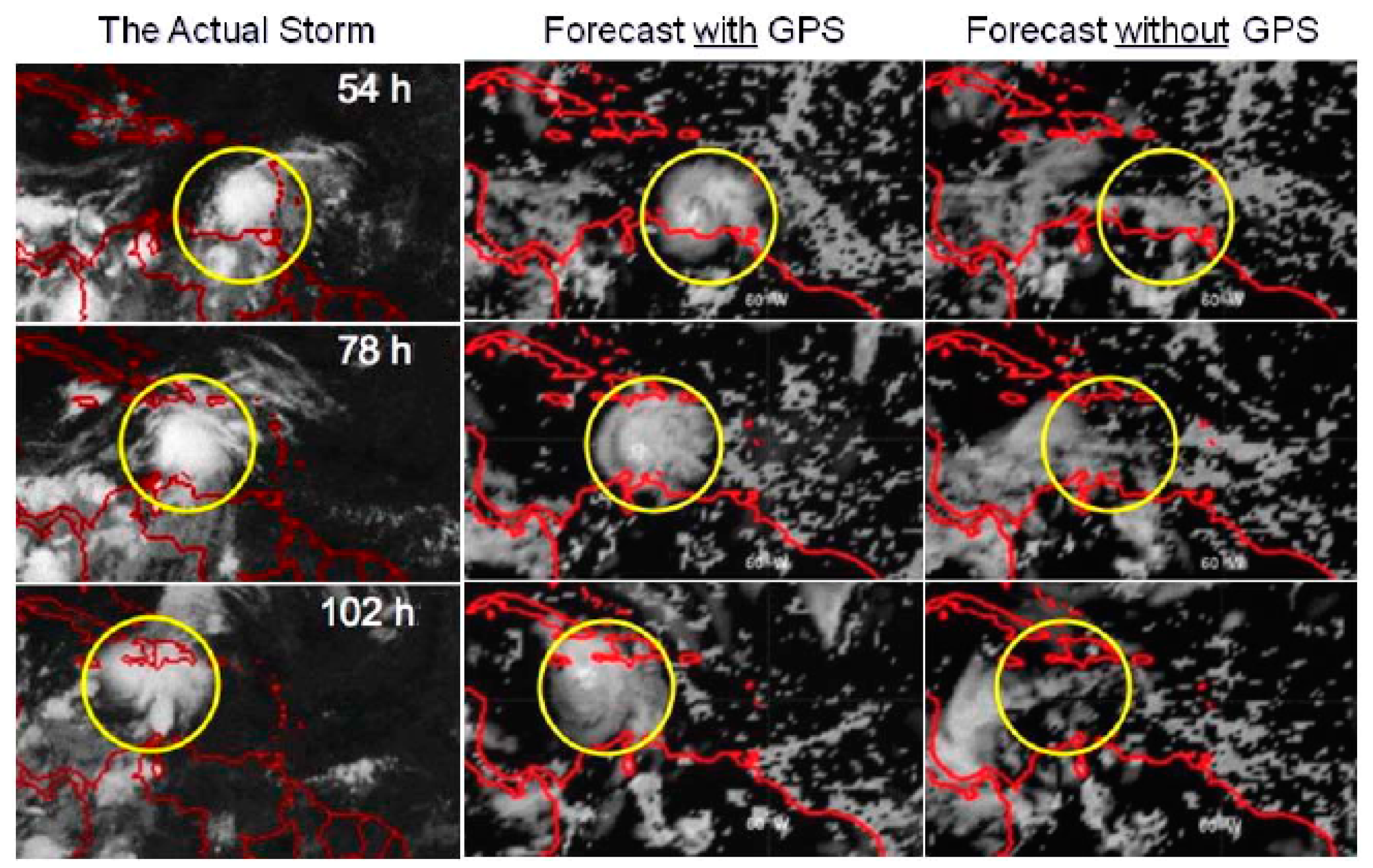
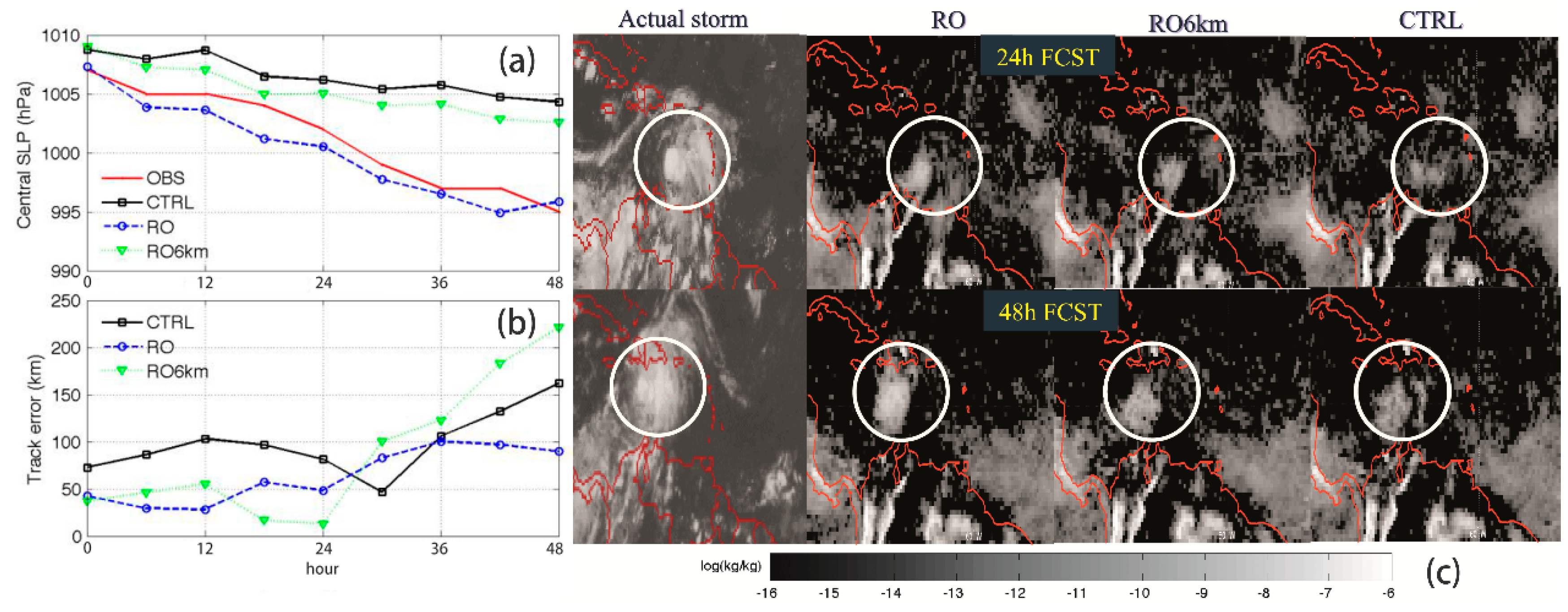


| Mission | Soundings/Day |
|---|---|
| COSMIC-2 | 5000 |
| MetOp-A/B/C | 1905 |
| FY-3C/D | 1000 |
| TanDEM-X | 100 |
| TerraSAR-X | 200 |
| KOMPSAT-5 | 500 |
| PAZ | 300 |
| Total data | 9005 |
| Actual received data | ~6000 |
| Data used | ~5000 |
| Observation | Assimilation Operator |  |
| Refractivity | Local refractivity | |
| Non-local refractivity | ||
| Non-local excess phase | ||
| Bending angle | Local bending angle | |
| 2D/3D Ray tracer |
| Sonder | GNSS Tracked | Soundings/Day | Satellite | Status |
|---|---|---|---|---|
| TriG | GPS, GALILEO | ~500 | COSMIC-2 | In orbit |
| ~600 | GRACE-FO | |||
| TriG (JASON-CS) | GPS, GALILEO, GLONASS | ~1000 | JASON-CS-A/B | Planned |
| GNOS | GPS, BeiDou | ~1000 | FY-3D | In orbit |
| GNOS-2 | FY-3E/F/G/H/R | Planed | ||
| GRAS | GPS | ~650 | MetOp-A/B/C | In orbit |
| RO | GPS, Galileo, GLONASS, Beidou (2 or 3 of them) | ~1100-1500 | MetOp-SG-A/B | Planned |
| IGOR | GPS | ~100 | TanDEM-X | In orbit |
| ~200 | TerraSAR-X | |||
| TSX-NG | Planned | |||
| ARMA-MP | GPS, Galileo, GLONASS | ~2000 | Meteor-MP | Planned |
Publisher’s Note: MDPI stays neutral with regard to jurisdictional claims in published maps and institutional affiliations. |
© 2020 by the authors. Licensee MDPI, Basel, Switzerland. This article is an open access article distributed under the terms and conditions of the Creative Commons Attribution (CC BY) license (http://creativecommons.org/licenses/by/4.0/).
Share and Cite
Bai, W.; Deng, N.; Sun, Y.; Du, Q.; Xia, J.; Wang, X.; Meng, X.; Zhao, D.; Liu, C.; Tan, G.; et al. Applications of GNSS-RO to Numerical Weather Prediction and Tropical Cyclone Forecast. Atmosphere 2020, 11, 1204. https://doi.org/10.3390/atmos11111204
Bai W, Deng N, Sun Y, Du Q, Xia J, Wang X, Meng X, Zhao D, Liu C, Tan G, et al. Applications of GNSS-RO to Numerical Weather Prediction and Tropical Cyclone Forecast. Atmosphere. 2020; 11(11):1204. https://doi.org/10.3390/atmos11111204
Chicago/Turabian StyleBai, Weihua, Nan Deng, Yueqiang Sun, Qifei Du, Junming Xia, Xianyi Wang, Xiangguang Meng, Danyang Zhao, Congliang Liu, Guangyuan Tan, and et al. 2020. "Applications of GNSS-RO to Numerical Weather Prediction and Tropical Cyclone Forecast" Atmosphere 11, no. 11: 1204. https://doi.org/10.3390/atmos11111204
APA StyleBai, W., Deng, N., Sun, Y., Du, Q., Xia, J., Wang, X., Meng, X., Zhao, D., Liu, C., Tan, G., Liu, Z., & Liu, X. (2020). Applications of GNSS-RO to Numerical Weather Prediction and Tropical Cyclone Forecast. Atmosphere, 11(11), 1204. https://doi.org/10.3390/atmos11111204




